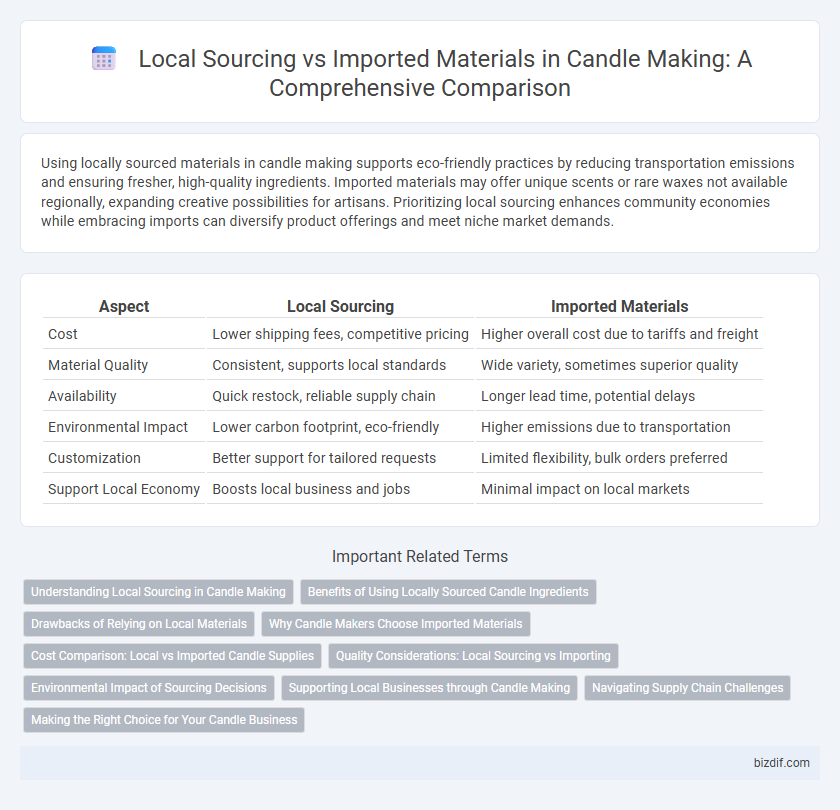Using locally sourced materials in candle making supports eco-friendly practices by reducing transportation emissions and ensuring fresher, high-quality ingredients. Imported materials may offer unique scents or rare waxes not available regionally, expanding creative possibilities for artisans. Prioritizing local sourcing enhances community economies while embracing imports can diversify product offerings and meet niche market demands.
Table of Comparison
| Aspect | Local Sourcing | Imported Materials |
|---|---|---|
| Cost | Lower shipping fees, competitive pricing | Higher overall cost due to tariffs and freight |
| Material Quality | Consistent, supports local standards | Wide variety, sometimes superior quality |
| Availability | Quick restock, reliable supply chain | Longer lead time, potential delays |
| Environmental Impact | Lower carbon footprint, eco-friendly | Higher emissions due to transportation |
| Customization | Better support for tailored requests | Limited flexibility, bulk orders preferred |
| Support Local Economy | Boosts local business and jobs | Minimal impact on local markets |
Understanding Local Sourcing in Candle Making
Local sourcing in candle making prioritizes obtaining wax, fragrances, and wicks from nearby suppliers to ensure sustainability and reduce carbon footprint. Utilizing locally sourced beeswax or soy wax enhances the quality and supports regional economies while offering fresher and more natural ingredients. This approach also allows artisans to tailor their products with unique, region-specific scents and materials that appeal to eco-conscious consumers.
Benefits of Using Locally Sourced Candle Ingredients
Locally sourced candle ingredients reduce transportation emissions, supporting environmental sustainability while ensuring fresher, higher-quality raw materials. Using local beeswax, soy, and essential oils strengthens community economies by promoting small-scale farmers and suppliers. This approach enhances ingredient transparency, allowing artisans to create candles with unique regional scents that appeal to eco-conscious consumers.
Drawbacks of Relying on Local Materials
Relying solely on local materials for candle making can limit the variety of unique scents and additives available, restricting creativity and product differentiation. Local sourcing may result in inconsistent quality due to seasonal variations and smaller supply chains, which can affect the final candle performance. Higher costs and limited availability during off-seasons also challenge scalability and competitive pricing in the market.
Why Candle Makers Choose Imported Materials
Candle makers often choose imported materials due to the superior quality and unique properties of essential oils, waxes, and fragrances that may not be available locally. Imported materials like soy wax from the U.S. or fragrance oils from France offer consistency, variety, and enhanced scent throw, which are critical for premium candle production. Access to specialized raw materials supports innovation and meets consumer demand for diverse and high-performance candles.
Cost Comparison: Local vs Imported Candle Supplies
Local candle supplies often reduce costs by eliminating high shipping fees and import taxes, making them more budget-friendly for small-scale candle makers. Imported materials can offer unique scents or specialized waxes but frequently come with increased expenses due to tariffs and longer delivery times. Choosing local sourcing supports quicker restocking and cost efficiency, essential factors in candle production profitability.
Quality Considerations: Local Sourcing vs Importing
Quality considerations in candle making significantly differ between local sourcing and importing materials. Locally sourced waxes and fragrances often offer superior freshness and traceability, ensuring consistent performance and safety standards. Imported materials may provide cost advantages but require rigorous quality checks due to variable standards and longer transit times impacting ingredient integrity.
Environmental Impact of Sourcing Decisions
Local sourcing in candle making significantly reduces carbon emissions by minimizing transportation distances, lowering the overall environmental footprint compared to imported materials. Using locally harvested wax and natural additives supports sustainable agriculture and decreases reliance on fossil fuels in shipping. Imported materials often involve extensive packaging and long-distance freight, contributing to increased greenhouse gas emissions and environmental degradation.
Supporting Local Businesses through Candle Making
Sourcing materials locally for candle making strengthens community economies by supporting nearby suppliers and artisans, ensuring fresher, high-quality ingredients such as beeswax and essential oils. Utilizing locally sourced raw materials reduces carbon footprints and promotes sustainable practices, aligning with eco-conscious consumer demands. Investing in regional resources also fosters unique candle blends inspired by local flora, differentiating products in a competitive market.
Navigating Supply Chain Challenges
Navigating supply chain challenges in candle making involves balancing local sourcing and imported materials to ensure quality and cost-efficiency. Utilizing local suppliers reduces lead times and supports sustainability efforts, while imported waxes and fragrances often offer unique properties and competitive pricing. Effective supply chain management requires assessing material reliability, supplier responsiveness, and market demand fluctuations to maintain consistent production.
Making the Right Choice for Your Candle Business
Choosing between local sourcing and imported materials significantly impacts candle quality, cost, and sustainability. Local sourcing ensures fresher, eco-friendly ingredients with reduced carbon footprint and supports community businesses, while imported materials may offer unique scents or cost advantages but involve longer lead times and higher shipping costs. Prioritizing factors like ingredient freshness, price stability, and brand values helps candle makers make the right choice for maintaining product consistency and appealing to eco-conscious consumers.
Local sourcing vs Imported materials Infographic

 bizdif.com
bizdif.com